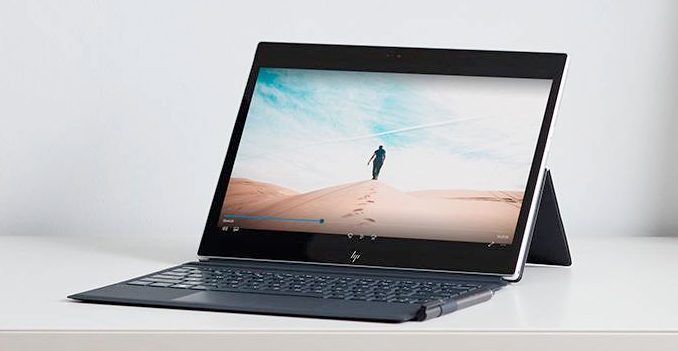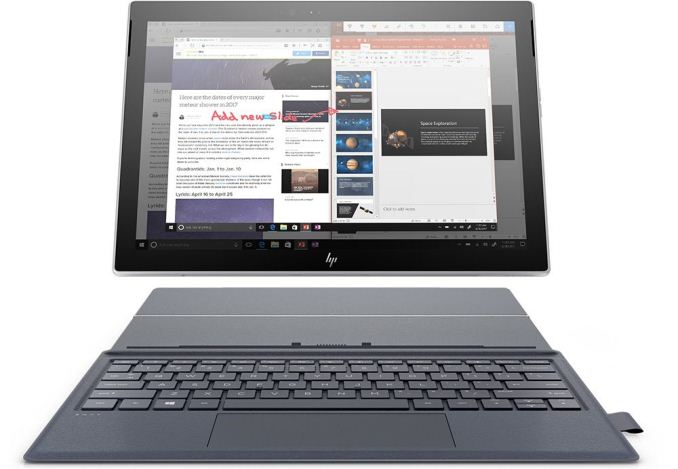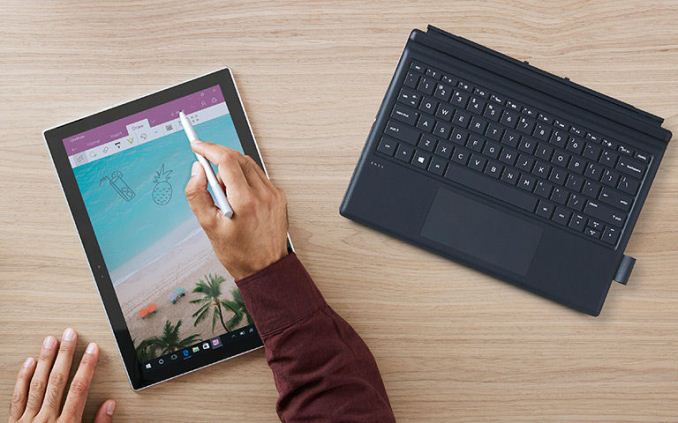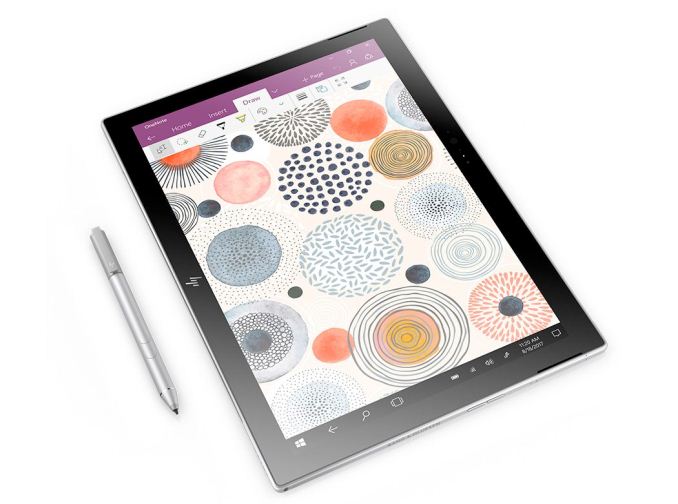HP’s Snapdragon 835-Based Envy X2 2-in-1 Available for Pre-Order, Starts at $999
by Anton Shilov on February 24, 2018 10:00 AM EST- Posted in
- Notebooks
- Systems
- HP
- 2-in-1
- Snapdragon 835
- Windows 10 S
- SD835
- HP Envy x2
- Envy x2

HP has started to take pre-orders on its new Envy X2 2-in-1 notebook based on Qualcomm’s Snapdragon 835 SoC and Windows 10 S. The 12.3” device is designed as a thin always connected unit, and rated for up to 22 hours on one charge. The price of the new Envy X2 is higher than we imagined when these devices were first announced: it starts at $999.
The 2018 HP Envy X2 2-in-1 detachable laptop comes with a 12.3” WUXGA+ touch-enabled display covered with Corning Gorilla Glass. The system runs the Qualcomm Snapdragon 835 SoC equipped with 4 GB of LPDDR4-3733 DRAM and 128 GB of eUFS storage (models with enhanced DRAM and storage are expected to be available later). The PC’s physical interfaces include one physical USB 3.1 Type-C header (with DisplayPort and USB Power Delivery support), a microSD card reader, and a 3.5-mm TRRS audio input. Wireless connectivity capabilities comprise of a 2x2 802.11ac Wi-Fi module with Bluetooth 5, and the built in Gigabit LTE modem from the SoC. The built-in SoC modem is meant to be one of the key features of the Envy X2 - it makes the device always connected in all areas with 3G and/or 4G networks, which essentially means everywhere in well-developed countries. For imaging, the device uses a 13 MP rear camera and a 5 MP front-facing camera.
The new Envy X2 is equipped with a 49.33 Wh battery that is rated to enable up to 19 hours of continuous video playback (at 150 nits brightness) or up to 22 hours of mixed-use workloads (HP does not tell how it tested these).
When it comes to portability, the HP Envy X2 is in line with professional tablets and advanced thin-and-light notebooks. The tablet itself it is 6.85 mm (0.27”) thick and weighs 698.5 grams (1.54 lbs), which is comparable to Apple iPad Pro 12.9”. When outfitted with a keyboard, the weight of the new Envy X2 bumps to 1.211 kilograms (2.67 lbs), which is similar to fully-fledged 13”-class laptops.
HP lists the S835 as running at 2.2 GHz base and 2.6 GHz turbo, which is typically how we describe an x86 PC, not a smartphone SoC: the S835 has two sets of cores, normally listed as 1.90 GHz on the efficiency cores and 2.45 GHz on the performance cores, neither of which correlates to HPs listing. So either this is a faster Snapdragon S835 bin, or there is miscommunication in the specification sheet. In this form factor there is a better opportunity for more cooling, which would be suitable for a higher frequency bin of SoC. But nonetheless, the 2.2-2.6 GHz listed on HP's website is not telling the whole story.
| Specifications of the HP Envy X2 (2018) | ||
| Model 12-e011nr | ||
| Display | 12.3" 1920×1280 187 PPI |
|
| CPU | Qualcomm Snapdragon 835 4 x Kryo 280 Performance (2.2 GHz - 2.6 GHz) 4 x Kryo Efficiency (? GHz) |
|
| Graphics | Adreno 540 GPU at 710 MHz | |
| RAM | 4 GB | |
| Storage | 128 GB eUFS | |
| Wi-Fi | Qualcomm WCN3990 2×2 802.11ac Wi-Fi |
|
| Bluetooth | Bluetooth 5 | |
| WWAN | Qualcomm X16 Gigabit LTE | |
| USB | 3.0 | 1 × Type-C |
| Cameras | Front | 5 MP |
| Rear | 13 MP | |
| Other I/O | Microphone, stereo speakers, audio jack, trackpad, MicroSD card reader, etc. | |
| Battery | 49.33 Wh | |
| Battery Life | 19-22 hours | |
| Dimensions | Width | 292.8 mm | 11.53" |
| Height | 210.3 mm | 8.28" | |
| Thickness | 6.85 mm | 0.27” (tablet only) | |
| Weight | Tablet | 698.5 grams | 1.54 lbs |
| Tablet+KB | 1.211 kilograms | 2.67 lbs | |
Like all Envy-branded devices, the new Envy X2 is designed to offer a premium experience: it comes in a brushed aluminum enclosure, features an audio sub-system co-developed with Bang & Olufsen, has a full-size magnetically attached keyboard/cover, and a stylus supporting Windows Ink technology (it is plausible to assume that the pen supports at least 1024 levels of sensitivity, but HP has not formally confirmed that). This premium look and feel comes at a price.
The Envy X2 model with 4 GB of RAM and 128 GB of NAND flash storage costs $999.99 and will ship on March 9. By contrast, the ASUS NovaGo TP370 with 8 GB of RAM and 128 GB of storage is priced at $799, whereas Lenovo’s Miix 630 is also expected to start from $799. Apple’s iPad Pro 12.9” with 4 GB of RAM, 64 GB of storage, a 4G/LTE modem and a keyboard is priced at $1197 (a version with 256 GB of NAND, a keyboard and stylus costs $1347), evidently HP aims its new Envy X2 at the same segment.
The latest HP Envy X2 is a product of Microsoft’s new attempt to marry nearly full-sized Windows and ARM. For HP, this is the first device running an ARM SoC and Windows for PCs. Several years ago, HP did not support Microsoft’s Windows RT (the software giant’s previous failed shot for ARM) and decided to focus on Atom- and then Core M-based Envy X2 running Windows 8/8.1/10 instead (many of such systems cost less than $1000). This time HP decided to go with S835 in a bid to offer a sleek always-connected Windows 10 device with an extra-long battery life. Since it is an Envy, it is priced accordingly and it remains to be seen whether end users are willing to spend this amount of money on this device. Obviously, the new Envy X2 is always connected and can work for a long time on one charge, but in Windows 10 S environment it can only run either specially-optimized applications, or perform binary translation (or another form of emulation) for 32-bit x86 applications (64-bit x86 apps are not supported) which naturally results in reduced performance.
Related Reading
- Lenovo Unveils Miix 630 2-in-1: Windows 10 S, Snapdragon 835, Gigabit LTE, 20 Hrs
- ASUS Announces the NovaGo (TP370): A Snapdragon 835 based Windows 10 PC
- Microsoft Launches Windows 10 On ARM: Always Connected PCs
- Microsoft and Qualcomm Collaborate to Bring Windows 10 & x86 Emulation to Snapdragon Processors
Source: HP














42 Comments
View All Comments
shabby - Saturday, February 24, 2018 - link
This might sell well for $499 with its weak hardware and limited software, but good luck hp.speculatrix - Saturday, February 24, 2018 - link
maybe $600 at most.Old_Fogie_Late_Bloomer - Saturday, February 24, 2018 - link
I get why they're thinking they can price this at $999 against an iPad Pro. It comes standard, I assume, with the keyboard and pen that you pay extra for when buying an iPad.To be clear, I think they're being delusionally optimistic. I'm interested in a cellular-less Windows on ARM tablet in the $200-$300 range, maybe. But I have no need for this.
Then again, maybe they think it'll be a big winner in the corporate world. And to be fair, they could absolutely be right; I could definitely see this working pretty well for the C-level set. And if success here inspires them to make cheaper devices, then great.
As for me, I just did a Google search and it looks like no-name Chinese OEMs are making Cherry Trail devices that already fit my needs and price and I'm wondering why I'm even bothering to wait. But hey, maybe this'll finally give me the phablet running full Windows (albeit on ARM) that I want. Full day battery life, >=1080p >=6" screen, <$400, Verizon/AT&T unlocked compatibility...here's hoping.
HStewart - Saturday, February 24, 2018 - link
I would agree that $200-300 (at most) would be only way I would consider one of these machine. Makers should be shamed for trying to selling one of these at full prices taunting higher battery life and unknowing customer purchase and wonder about the performance.No matter what Microsoft is saying about Windows 10 on ARM, this Windows RT all over again.
Only hope is low-power mobile device with 15+ battery life which supposedly the Dell XPS 15 2in1 is suppose to have - even more if they excluded the GPU - hopefully it can be disable at times
Fritzkier - Sunday, February 25, 2018 - link
I don't even...Are you guys delusional?
SD835 smartphone doesn't even exist at $300...
Let alone a first gen ARM laptop...
Though, as for me, I'll wait until reviewer review this devices. We don't know how Windows for ARM perform, yet.
Fritzkier - Sunday, February 25, 2018 - link
*Windows on ARMAnd I think, if only they optimized it on Mid range SOCs (like SD625, 650, etc) it would be a very good deal.
Manch - Monday, February 26, 2018 - link
I can tell you exactly how it will perform. Crappier than an AMD or Intel proc. The specs on this thing lines it up with the low end Surface Pro. 128/4 15 vs 128/4/835. Dimensions are nearly identical. With KB and pen the Surface is about 130$ more but for 130$ you get native x86/64 which means you can run everything. The SP has a by far way better display/pen/touch stack on top of the performance. This thing is priced way way too high. At a lower price point it would have faired better against a non pro surface but alas none exists. With discounts and a bit of shopping you can shrink down the 130$ margin a good bit which just makes the envy an even worse deal.frenchy_2001 - Monday, February 26, 2018 - link
The surface pro does not include neither keyboard nor pen at that price though.If you need those, you need to add over $150 to the bill.
But I agree this is too rich for my blood.
Manch - Tuesday, February 27, 2018 - link
I addressed that in my post. "With KB and pen the Surface is about 130$ more but for 130$ you get native x86/64 which means you can run everything"domboy - Monday, February 26, 2018 - link
"No matter what Microsoft is saying about Windows 10 on ARM, this Windows RT all over again."Yes and no. Windows 10 S is definitely Windows RT all over again (Intel or ARM). Windows 10 Pro ARM Edition however stands a chance to actually be a decent OS. It just needs a slightly more affordable device. I'm really hoping will see a non-Pro Surface released running it. That's what I want.